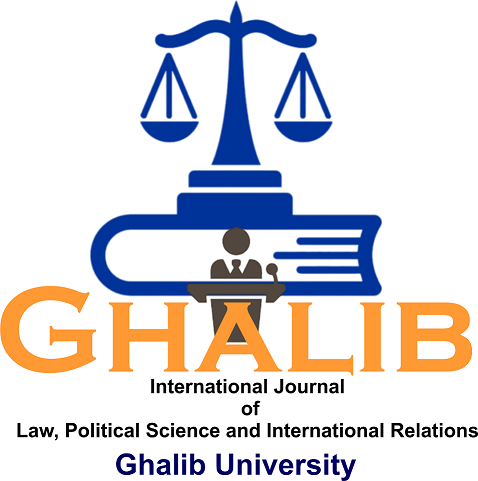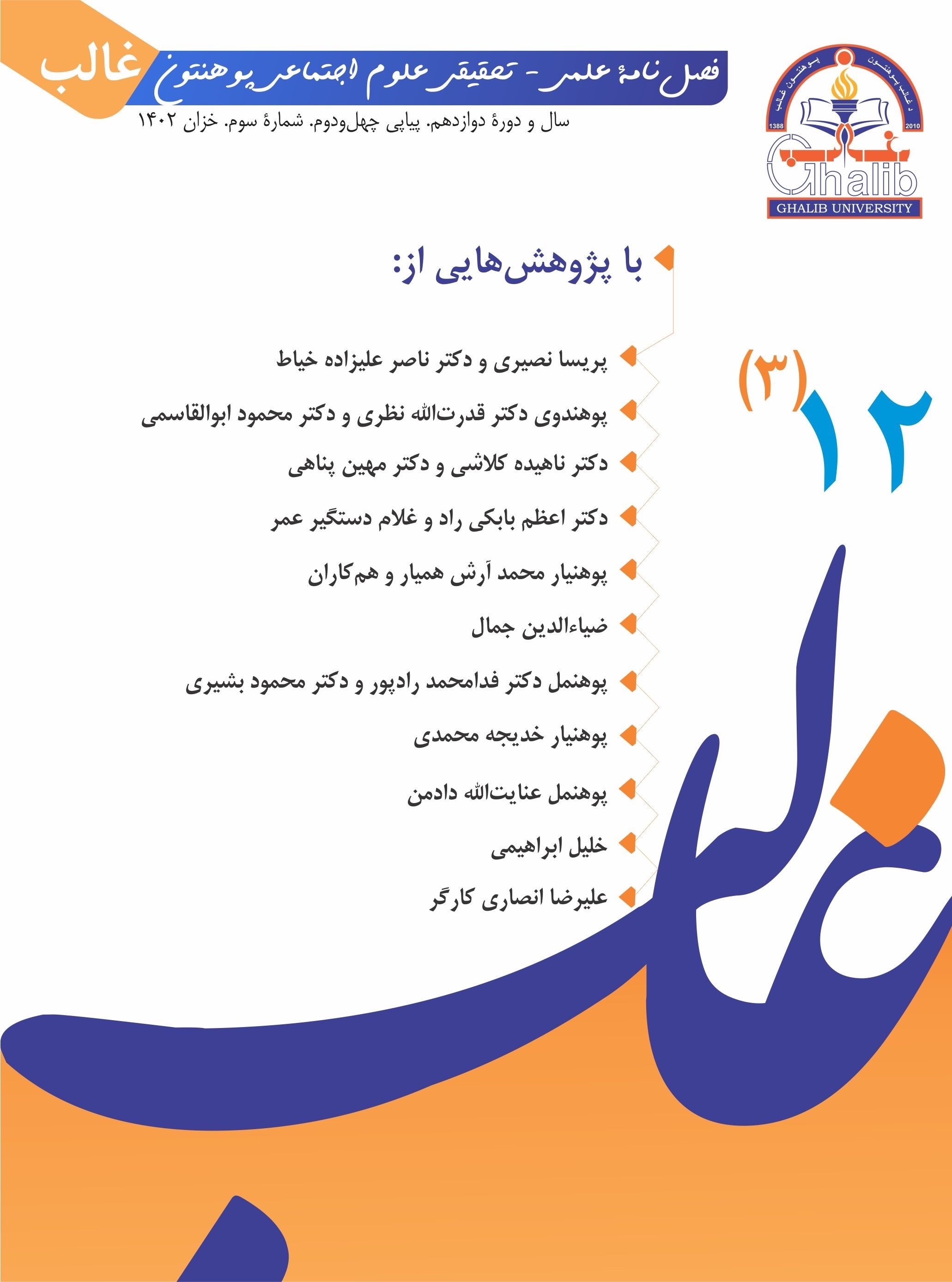ردِّ پایِ آیین شمنی در افغانستان
DOI:
https://doi.org/10.58342/ghalibqj.V.12.I.3.6واژهگانِ کلیدی:
آیین شمنی، افغانستان، آسیای میانه، فرهنگ و عادات اجتماعی، تخارچکیده
آیین شمنی، مجموعهٔ اعتقادات و سنّتهای اجتماعی تُرکان باستان است، که شامل باورهای دینی، روشهای ابتدایی تداوی، داستانهایی در مورد جهان و آفرینش آن، آداب و رسوم در مراسم تدفین، تولد نوزادان، ازدواج و مسائل دیگر میشود. بیشتر باورهای موجود در این نظام اعتقادی، متأثر از شیوهٔ زندهگیِ صحرانوردی و سوارکاری ترکان است و ریشههای آن تا بیستهزارسال قبل باز میگردد. باوجود تحولات عمیق فرهنگی در میان تُرکان و ازجمله چندینبار تغییر دین و آمیزش با فرهنگهای دیگر، آیین شمنی با اشکال مختلفی به حضورش ادامه داده و تا امروز، عُرف و عادات فراوان کیش شمنی در میان تُرکان مسلمان و اقوام نزدیک آنها وجود دارد، که افغانستان و بهویژه ولایات شمال آن، شامل این حوزه میشود. این مقاله در پی این بودهاست تا ردّ پای باورها و سنّتهای آیین شمنی را در جامعهٔ امروز افغانستان جستوجو نماید. این جستوجو به اساس مشاهدات عینی نویسنده و در روشنایی تحقیقاتِ اِسنادی موجود که به گردآوری باورهای پراگندهٔ کیش شمنی تحت یک نظام اعتقادی واحد پرداختهاند شکل گرفته است. تحقیقات علمییی که این مطالعه متکی به آن است، عبارت از آثار پژوهشگران غربی، تُرک و فارسیزبان میباشد؛ از اینرو شیوهٔ این تحقیق، توصیفی-تحلیلی است و روش تطبیق و مقایسهٔ یافتههای علمی در مورد آیین شمنی با عادات موجود اجتماعی مردم شمال افغانستان نیز بهکار رفته است. ساحهٔ مورد مطالعه تحقیق، ولایات شمالی افغانستان، بهویژه رسوم اجتماعی مردم ولایت تخار در شرایط امروزی میباشد. در این مقاله تلاش شده است که ریشههای تاریخی و اعتقادی بسیاری از باورها و رسوم اجتماعی مردم شمال افغانستان که اکثراً موهوم و ناشناخته پنداشته میشود، مورد بررسی قرار گیرد و پیوندشان با باورهای باستانی شمنباوری مشخص گردد.
سرچشمهها/ منابع
آژانس خبری پژواک، (1 اسد 1402 ه ش)، «حکایت تلخِ موتر سوخته؛ در تخار، یک مرد بیش از سه دهه میشود در قبرستان قربانیان یک رویداد مرگبار زندهگی میکند». برداشت (2اسد 1402). قابل دسترس در: <https://pajhwok.com/fa/2023/07/23/the-bitter-story-of-burnt-car-in-takhar-a-man-has-been-living-in-the-cemetery-of-the-victims-of-a-deadly-event-for-more-than-three-decades/>.
استاتلی، مارگات. (1396). مقدمه¬ای بر شامانیسم. ترجمهٔ بیژن اسدیمقدم. ایران: نگین سبلان.
بارتولد، و. و. (1352). ترکستان¬نامه. ج اول. ترجمهٔ کریم کشاورز. ایران: بنیاد فرهنگ ایران.
4. عابدوف، داداجان. (1394)، آداب، آیینها و باورهای مردم افغانستان. کابل: انستیتیوت مطالعات استراتیژیک افغانستان.
مخبردزفولی، فهمیه. (1384). «ترکان از آیین شمنی تا اسلام». ایران: مجلهٔ علمی-پژوهشی تاریخ و تمدن اسلامی. شمارهٔ 1. صص. 49-69. <https://jhcin.srbiau.ac.ir/article_4832.html>.
نیکوبخت، ناصر؛ قاسمزاده، سیدعلی. (1388). «روشهای خلسهگی شمنیسم در برخی از فرقههای تصوف». ایران: مجلهٔ مطالعات عرفانی. (9). 185-216. https://sid.ir/paper/123357/fa>.
Davletov, Timur B. (2021), Sibirya’dan Anadolu’ya Türk Şamanizmi’nin Sosyolojisi, İstanbul: Urzeni Yayınevi.
Dupaigne, Bernard, (2013), “Shamans in Afghanistan”, Shamanism and Islam, Edu. Thierry Zarcone and Angela Hobart, London: I. B. Tauris and Co Ltd, 2013.
Ermetin, Günnur Yücekal, (2009), Mevlevilikte Şamanizm İzleri, İstanbul: Töre Yayınevi.
İnan, Abdülkadir, (1986) Tarihte ve Bugün Şamanizm, Ankara, Türk Tarih Kurumu.
İzgi, Mustafa Cumhur, (2012), “Şamanizm ve Şamanlara Genel bir Bakış”, Ankara: Lokman Hekim Journal, 2 (1).
İzgi, Özkan, (2020), Orta Asya Türk Tarihi Araştırmaları, Ankara: Türk Tarih Kurumu.
Mömin, Samire, (2013), “Şamanizm ve Günümüzdeki Kalıntıları”, Ankara: Ulakbilge Dergisi, c. 1, sayı 1, (79-89).
Roux, Jean-Paul, (2001), Orta Asya Tarih ve Uygarlık, İstanbul: Kabalcı Yayınevi.
Sultanova, Razia, (2011), From Shamanism to Sufism, Women, Islam and Culture in Central Asia, London: I. B. Tauris and Co Ltd.
References
Abedov, Dadajan, (2014), Manners, Rituals and Beliefs of the People of Afghanistan, Kabul: Institute of Strategic Studies of Afghanistan. (Persian)
Davletov, Timur B. (2021), Sociology of Turkish Shamanism from Siberia to Anatolia, Istanbul: Urzeni. (Turkish)
Dupaigne, Bernard, (2013), “Shamans in Afghanistan”, Shamanism and Islam, Edu. Thierry Zarcone and Angela Hobart, London: I. B. Tauris and Co Ltd, 2013. (English)
Ermetin, Günnur Yücekal, (2009), Traces of Shamanism in Mevlevi, Istanbul: Töre. (Turkish)
Inan, Abdulkadir, (1986) Shamanism in History and Today, Ankara, Turkish Historical Society. (Turkish)
İzgi, Mustafa Cumhur, (2012), “Shamanism and an Overview of Shamans”, Ankara: Lokman Hekim Journal, 2 (1). (Turkish)
İzgi, Özkan, (2020), Central Asian Turkish History Studies, Ankara: Turkish Historical Society. (Turkish)
Mokhbardzfouli, Fahmieh, (Summer 2014), "Turks from Shamanism to Islam", Scientific Research Journal of Islamic History and Civilization, No. 1, pp. 49-69. (Persian)
Mömin, Samire, (2013), “Shamanism and Its Remains Today”, Ankara: Ulakbilge Journal, V. 1, number 1, (79-89). (Turkish).
Nikobakht, Nasser and Qasim-zadeh, Seyyed Ali, (spring and summer 2018), "The ecstatic methods of shamanism in some sects of Sufism", Esfani Studies, No. 9, pp. 185-216. (Persian)
Pajhwok News Agency, (1 Asad 1402 AH), "The bitter story of "burnt car" in Takhar; For more than three decades, a man lives in the cemetery of the victims of a fatal event", https://pajhwok.com/fa/2023/07/23/the-bitter-story-of-burnt-car-in-takhar-a -man-has-been-living-in-the-cemetery-of-the-victims-of-a-deadly-event-for-more-than-three-decades/ (Persian)
Roux, Jean-Paul, (2001), Central Asian History and Civilization, Istanbul: Kabalcı. (Turkish)
Statley, Margat, (2016), an introduction to shamanism, translated by Bijan Asadi Moghadam, Negin Sablan.
Sultanova, Razia, (2011), From Shamanism to Sufism, Women, Islam and Culture in Central Asia, London: I. B. Tauris and Co Ltd. (English)
Barthold, V. V. (1352), Turkestannameh, first volume, translated by Karim Keshavarz, Iran: Foundation of Iran Farhang.
چاپ شده
ارجاع به مقاله
شماره
نوع مقاله
مجوز
حق نشر 2023 فصلنامۀ علمی - پژوهشی غالب

این پروژه تحت مجوز بین المللی Creative Commons Attribution 4.0 می باشد.













